Overview
This article delves into the best practices for establishing a successful Center of Excellence (CoE) in analytics. It highlights strategies that significantly enhance organizational analytical capabilities. Key components include:
- Leadership support
- Experienced teams
- Clear objectives
- Robust governance
Together, these elements cultivate a culture of data-driven decision-making and operational efficiency. Ultimately, this approach leads to improved business outcomes that every organization strives for.
Introduction
In an age where data reigns supreme, organizations are increasingly turning to Centers of Excellence (CoEs) in analytics to harness the power of their data assets. These centralized hubs not only consolidate expertise and resources but also foster a collaborative environment that drives innovation and strategic alignment across departments. As companies navigate the complexities of data management, establishing a high-performing analytics CoE has become essential for translating vast amounts of information into actionable insights.
By integrating advanced technologies like Robotic Process Automation and adopting best practices for data governance, organizations can enhance decision-making processes and achieve measurable success. This article delves into the key components and methodologies that underpin a successful analytics CoE, highlighting the importance of leadership support, skilled teams, and continuous innovation in unlocking the full potential of data analytics.
Understanding the Center of Excellence in Analytics
A Center of Excellence (CoE) in data analysis, known as coe analytics, acts as a centralized hub that consolidates expertise, resources, and best practices, significantly enhancing an organization’s analytical capabilities. By fostering teamwork, innovation, and strategic alignment, the CoE unites scientists, analysts, and business stakeholders to advance information initiatives closely aligned with organizational objectives. This integration prevents data analysis efforts from becoming isolated, cultivating a culture of shared insights and informed decision-making across departments.
In today’s information-rich landscape, creating a CoE is particularly advantageous. Organizations face the challenge of transforming vast quantities of information into actionable insights. Current trends indicate that entities leveraging coe analytics are better positioned to harness insights for competitive advantage, as they can standardize practices and enhance information analysis capabilities. For instance, CoE analytics has successfully bridged the gap between business needs, data science, and technology, generating tangible value by aligning analytics vision with business strategy.
This alignment is essential. As Radu Arslanian, Sr. Principal Consultant in Informatica’s Advisory Services group, observes, “Gartner shows that 95% of organizations that establish a Cloud COE will deliver measurable cloud transformational success through 2021.”
Furthermore, integrating Robotic Process Automation (RPA) within the CoE can streamline manual workflows, enhancing operational efficiency and allowing teams to focus on strategic initiatives. RPA significantly reduces time spent on repetitive tasks, leading to improved productivity and accuracy. Since FY 2018, the Data Analytics Center of Excellence has effectively employed coe analytics tools and strategies to enhance decision-making and program results.
Industry insights further suggest that organizations establishing a CoE Analytics are likely to experience quantifiable transformational success. This highlights the importance of centralized data hubs in boosting operational efficiency and effectiveness. The Enterprise Big Data Framework offers practical guidance on developing data-driven decision-making and governance processes, which are crucial for enhancing analytical capabilities. As we approach 2025, the role of data Codes will continue to evolve, becoming increasingly vital for organizations aiming to fully leverage their data assets, particularly through tailored AI solutions and Business Intelligence strategies.
Creatum GmbH is committed to helping organizations navigate these challenges, ensuring they can effectively implement RPA and BI solutions to achieve their strategic objectives.
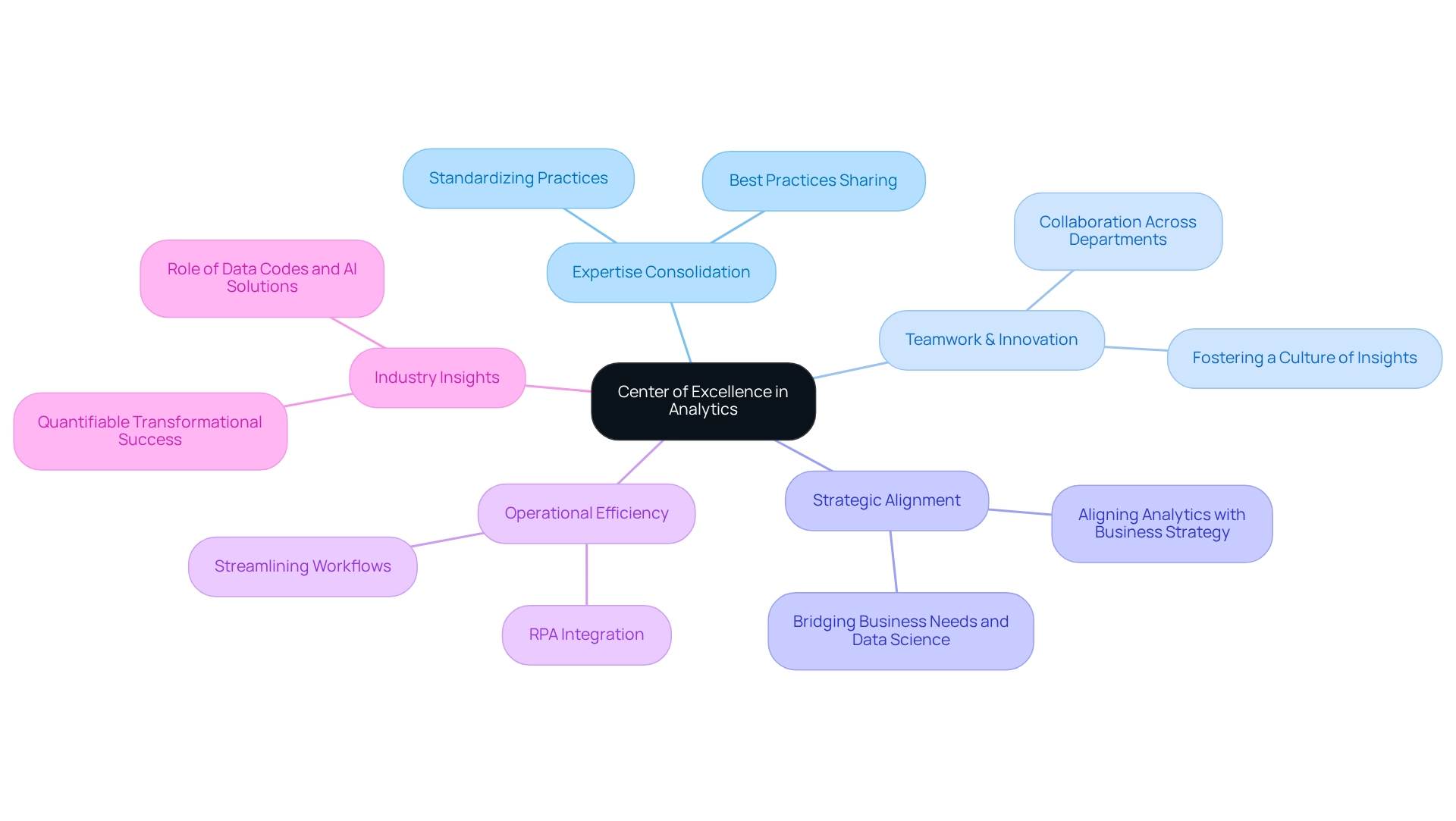
Key Components of a High-Performing Analytics CoE
A high-performing data analysis Center of Excellence (CoE) is characterized by several essential components that drive its success:
-
Leadership Support: Strong backing from senior management is vital for securing necessary resources and fostering a culture that prioritizes data-driven decision-making. Research shows that organizations with strong leadership backing for data initiatives can achieve a 25% improvement in overall results, highlighting the significance of executive involvement. Additionally, persuading a powerful audience is crucial, as they hold significant control over organizational resources and priorities. This leadership support is essential for leveraging Business Intelligence and Robotic Process Automation (RPA) to drive data-driven insights and operational efficiency through CoE analytics.
-
Experienced Group: A varied group equipped with knowledge in information science, analysis, and business intelligence is essential for efficient operations. This diversity not only enhances problem-solving capabilities but also promotes innovative approaches to CoE analytics challenges, ensuring that the CoE can adapt to evolving market demands. Leveraging AI through tailored solutions, such as Small Language Models and GenAI Workshops, can further enhance the group’s capabilities in data analysis and training, addressing specific challenges like poor master data quality and perceived AI complexities.
-
Clear Objectives: Establishing specific, measurable goals is essential for aligning the CoE’s activities with the organization’s strategic vision. This clarity helps teams focus their efforts on initiatives that drive meaningful impact, ultimately leading to improved decision-making speed and reduced operational costs. For instance, a retailer achieved a 30% boost in decision-making speed and reduced market research costs by 25% through effective analytics practices. Employing Power BI services, such as the 3-Day Sprint for quick report generation, can greatly improve information reporting and actionable insights through CoE analytics.
-
Collaboration Framework: A structured approach to collaboration among various departments fosters knowledge sharing and innovation. By breaking down silos, organizations can leverage collective expertise, leading to more comprehensive insights and enhanced performance across the board. This partnership is crucial for tackling information inconsistency and governance challenges in business reporting, ultimately improving decision-making.
-
Technology Infrastructure: Investing in the appropriate tools and technologies is essential for effective information management and analysis. A robust technology stack allows groups to harness data effectively, transforming raw information into actionable insights that inform strategic decisions. Integrating Robotic Process Automation (RPA) can simplify workflows, increase efficiency, and offer a risk-free ROI evaluation, enabling teams to concentrate on more strategic, value-enhancing tasks.
Integrating these elements not only improves the performance of CoE analytics but also positions firms to maintain a competitive advantage in an increasingly data-driven environment. Furthermore, continuous education is essential for leadership development, providing leaders with updated knowledge and skills necessary for effective decision-making and innovation. By nurturing leaders from within, entities can further improve their results, emphasizing the significance of robust leadership backing in data initiatives.
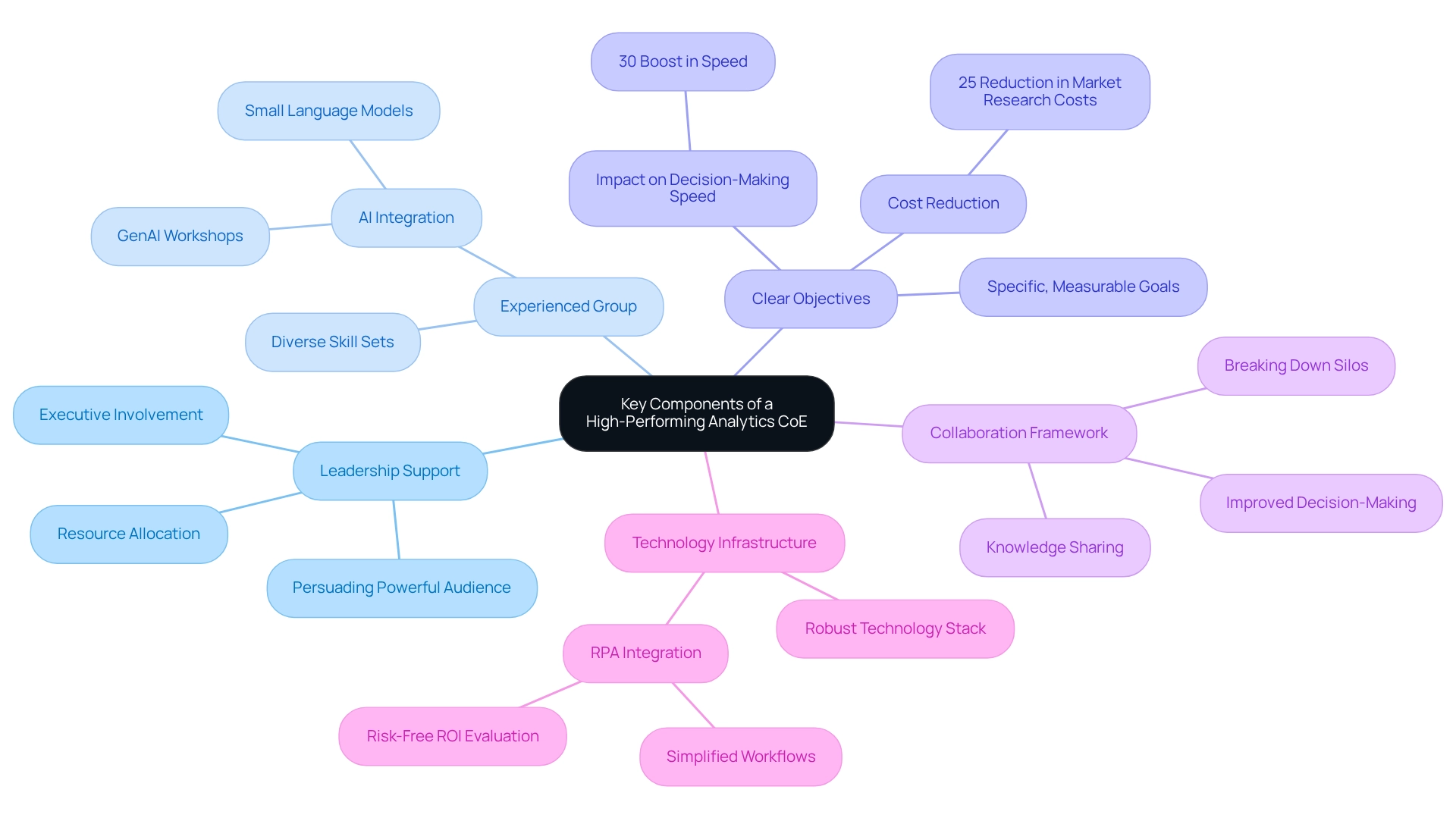
Ensuring Data Quality and Governance
Ensuring information quality and governance is crucial for entities aiming to utilize analytics efficiently. This necessitates the creation of comprehensive policies and procedures that regulate information management practices. Key strategies include:
-
Information Stewardship: Appointing dedicated information stewards to oversee quality and compliance fosters accountability and ensures that governance principles are upheld throughout the organization.
-
Regular Audits: Conducting periodic evaluations of information sources and processes is essential for identifying and rectifying quality issues. These audits help maintain high standards, ensuring that information remains trustworthy and precise.
-
Standardization: Implementing uniform information standards across the organization promotes consistency and reliability. This standardization is vital for effective information integration and supports overall digital transformation efforts, particularly in the context of Business Intelligence and RPA solutions provided by Creatum GmbH, such as EMMA RPA and Power Automate.
-
Training: Offering extensive instruction for staff on information governance principles enhances awareness and compliance with quality standards. An informed workforce is better equipped to handle information responsibly and effectively, especially when utilizing AI technologies like Small Language Models and participating in GenAI Workshops.
-
Feedback Mechanisms: Establishing pathways for input on quality concerns enables ongoing enhancement. Promoting transparent communication assists organizations in adjusting and refining their governance strategies over time.
In 2025, the significance of information management in analysis cannot be overstated. As emphasized by industry specialists, “Investing in the essential resources and staff is vital to cultivating a culture that utilizes technology and encourages innovation while aiming for steady performance enhancement,” states Koushik Nandiraju, an award-winning engineer. Organizations with robust governance frameworks report significantly enhanced information quality, which is essential for successful coe analytics initiatives.
For instance, a recent case study on information quality implementation demonstrated how combining information governance with contemporary catalog solutions can improve overall information observability and address a wider array of information quality challenges. This partnership not only enhances information management but also enables entities to derive significant insights from their information, ultimately fostering growth and innovation. Furthermore, measuring data quality with key metrics and KPIs is crucial for success, as poor data quality impedes organizations in embracing data integration and adopting IT solutions, making data quality integral to digital transformation.
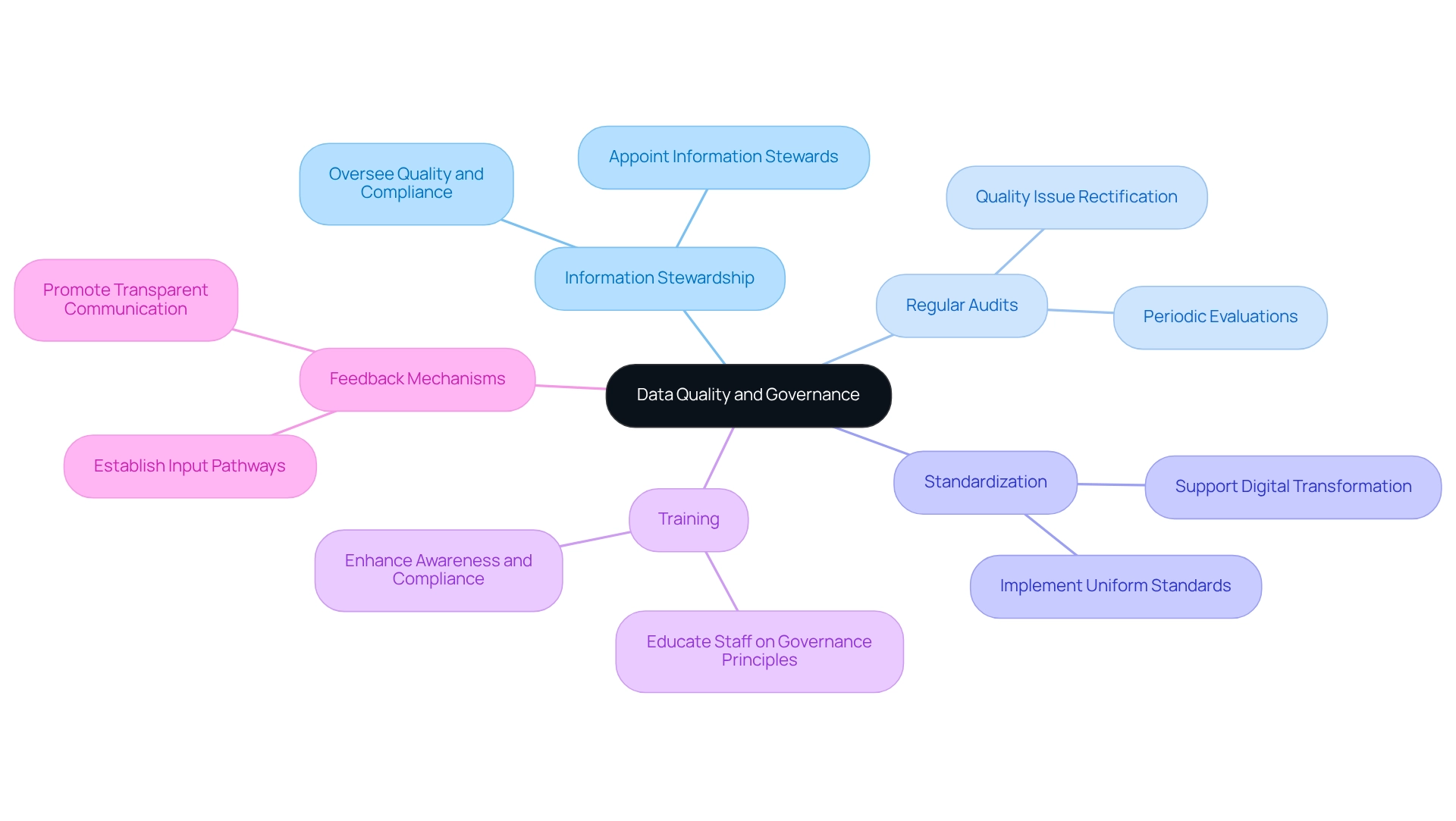
Optimizing Resources for Analytics Success
Enhancing resources for successful data analysis requires a strategic approach to the planning and distribution of both human and technological assets. Effective practices include:
-
Cross-Functional Groups: Forming teams with diverse skill sets not only enhances problem-solving capabilities but also fosters innovation. Analysis results significantly improve when individuals from various departments collaborate, bringing distinct perspectives and expertise. By reducing cycle time, teams can accomplish tasks more swiftly and efficiently, leading to increased productivity and cost savings, as highlighted by analyst Chris Bergh.
-
Technology Investment: Allocating budget towards advanced analytics tools and platforms is essential. Investing in solutions such as Creatum GmbH’s Power BI services, which feature the 3-Day Power BI Sprint for rapid report creation, and EMMA RPA can streamline processes and enhance data processing capabilities. Organizations leveraging cutting-edge technology often experience a notable increase in productivity and cost savings, effectively preventing burnout and project delays.
-
Performance Metrics: Establishing clear metrics for evaluating resource utilization is crucial. This practice helps identify inefficiencies and opportunities for improvement, allowing teams to focus their efforts where they are most needed. Analytics can reveal overlaps where multiple members may be engaged in similar tasks unnecessarily, underscoring the importance of efficient resource management.
-
Flexible Resource Allocation: A versatile approach to resource distribution enables organizations to adapt swiftly to changing analytical needs. This agility is vital in a fast-paced environment, ensuring that teams can pivot and respond to new challenges without hesitation.
-
Continuous Training: Ongoing training for data personnel is imperative to keep them adept in the latest tools and techniques. As technology evolves, so must the skills of the workforce. Investing in continuous education not only enhances individual competencies but also strengthens the overall data analysis function within the organization.
-
DataOps Principles and Observability: Implementing DataOps principles can assist in tracking and improving key metrics related to resource optimization. This approach ensures that teams consistently evaluate their performance and make data-driven decisions.
By applying these best practices, enterprises can maximize their resources effectively, leading to improved analytics outcomes and greater overall success in their operations. Creatum GmbH’s solutions, including RPA for automating manual workflows and Power BI for actionable insights, empower teams to overcome challenges such as staffing shortages and outdated systems, ultimately driving business growth. To discover how our solutions can benefit your organization, book a free consultation today.
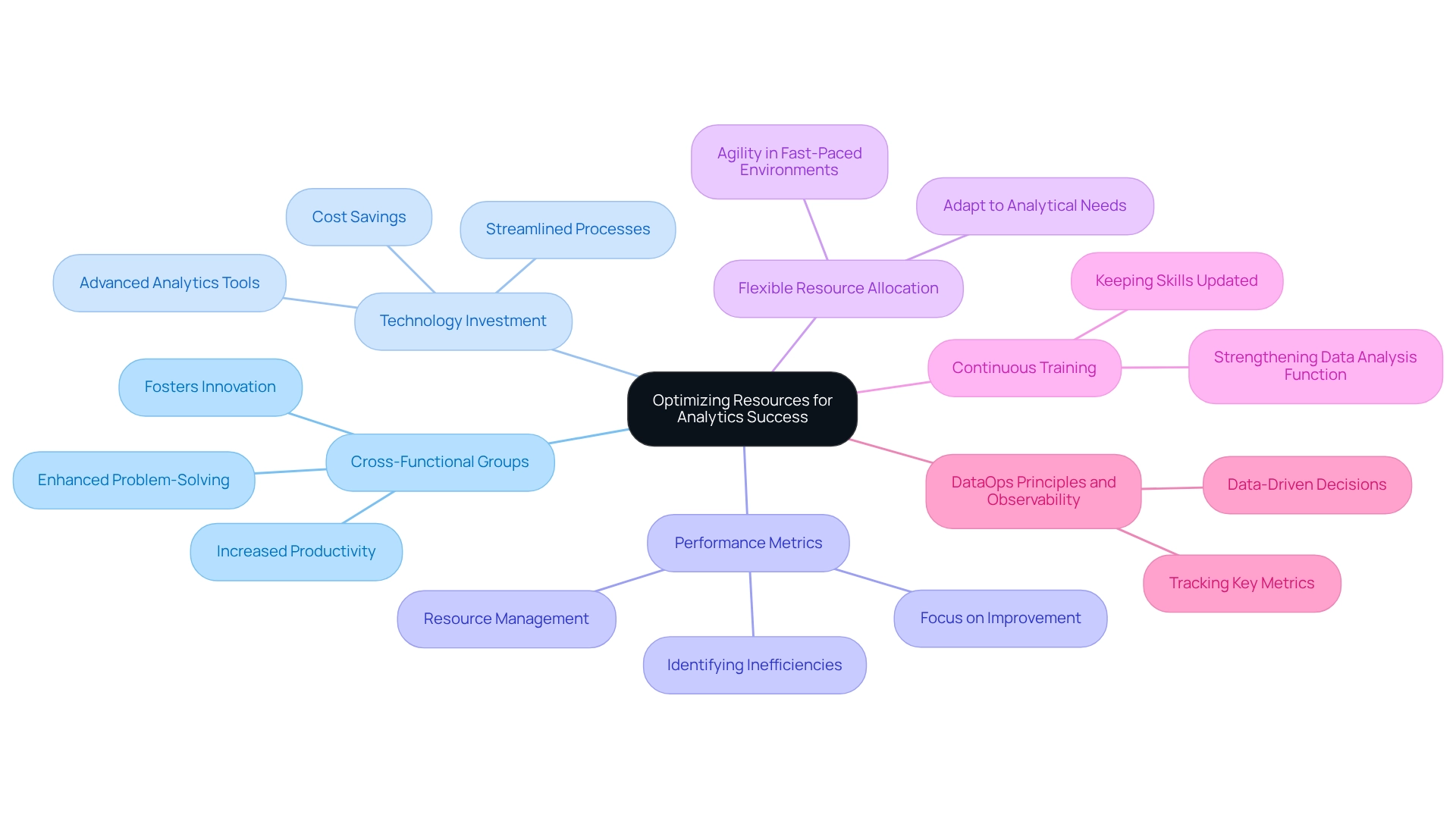
Fostering Knowledge Sharing and Collaboration
Fostering knowledge sharing and collaboration within a Center of Excellence (CoE) is crucial for enhancing overall effectiveness. The primary purpose of CoE analytics is to centralize expertise and resources, fostering a data-driven culture and driving strategic decision-making. Implementing targeted strategies can significantly enhance group performance and drive better outcomes.
Key strategies include:
-
Regular Workshops: Organizing interactive workshops, like those conducted by Sebastian Rusdorf from Creatum GmbH, promotes participants to share insights and best practices while fostering a culture of continuous learning. These sessions can be customized to tackle specific challenges encountered by the group, ensuring that knowledge is pertinent and practical. By focusing on method-based approaches, these workshops can yield tangible results in marine solutions and beyond.
-
Collaborative Tools: The adoption of advanced collaboration tools and platforms is essential for facilitating seamless communication and information sharing among group members. Tools such as shared dashboards and project management software enable real-time updates and foster a more integrated approach to analytics.
-
Mentorship Programs: Establishing mentorship programs that pair experienced analysts with newcomers is a powerful way to promote knowledge transfer. This relationship not only speeds up the onboarding process for new members but also enhances the overall skill set of the data analysis group, resulting in improved performance.
-
Recognition Programs: Implementing recognition and reward systems for collaborative efforts can significantly enhance teamwork. Recognizing contributions promotes a positive atmosphere where group members feel appreciated and inspired to participate in knowledge sharing.
-
Cross-Departmental Projects: Promoting initiatives that engage various departments enhances the comprehension of data applications throughout the company. This collaborative approach not only enhances the skill set of individual team members but also promotes a unified vision for data-driven decision-making.
As noted by Arif Abdelwhab Ali, the lack of knowledge sharing practices and the eminent loss of technical knowledge within the oil and gas industry create significant challenges for practitioners. By prioritizing these strategies, entities can create a robust framework for knowledge sharing within their CoE analytics, ultimately driving strategic decision-making and fostering a data-driven culture. Moreover, entities that swiftly deploy top talent for critical initiatives are more likely to deliver shareholder value, highlighting the significance of efficient collaboration and knowledge exchange. A recent study involving 203 responses from the oil and gas industry highlights the critical need for structured approaches to overcome common obstacles in establishing a CoE Analytics.
Additionally, leveraging technologies such as Robotic Process Automation (RPA) and tailored AI solutions can enhance operational efficiency and support informed decision-making, further driving business growth.
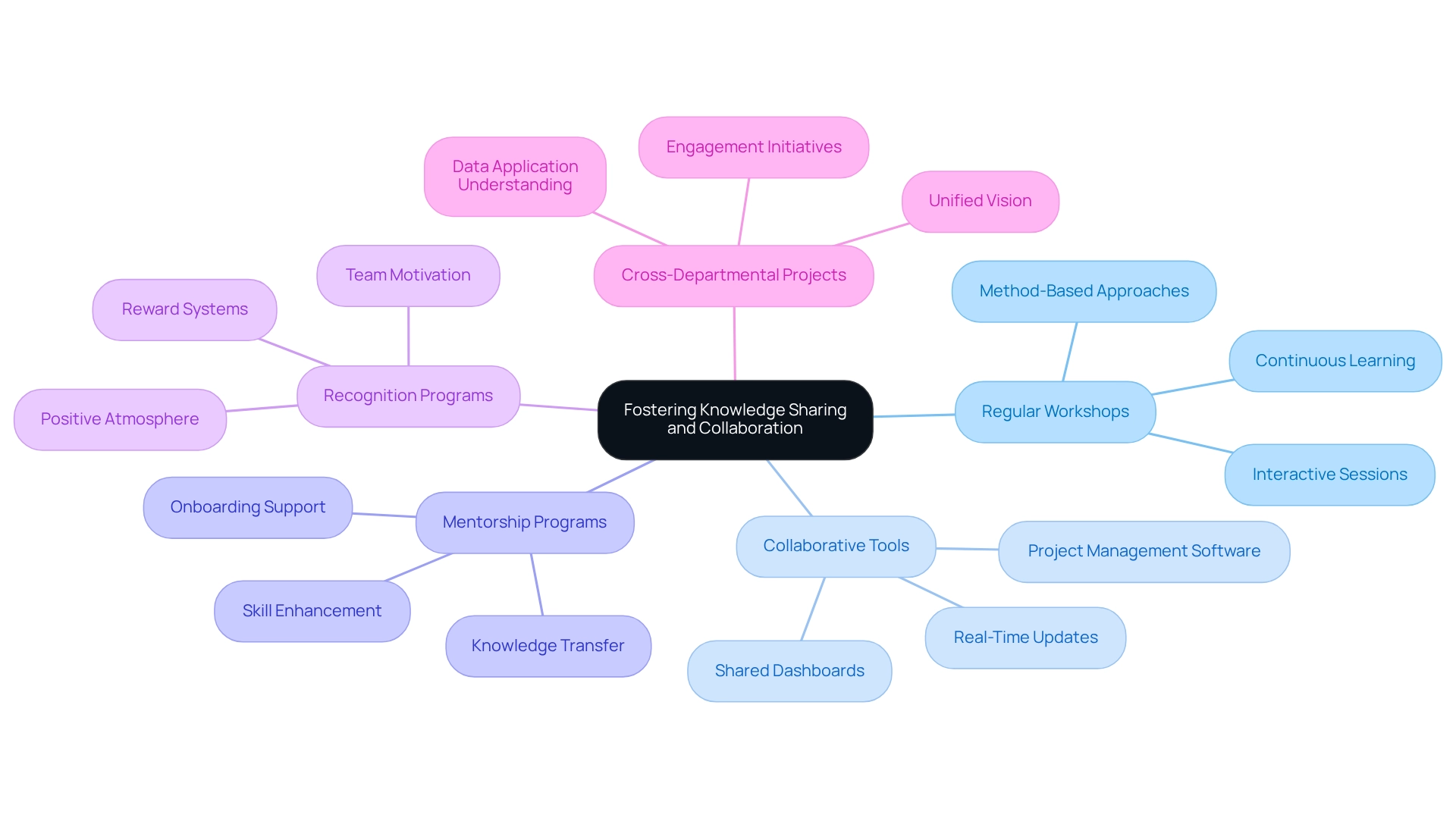
Driving Continuous Innovation in Analytics
Driving continuous innovation in coe analytics necessitates a proactive exploration of emerging methodologies and technologies. Key practices that entities can adopt include experimentation, feedback loops, collaborations, innovation labs, and regular reviews.
Experimentation is crucial. Fostering a culture of experimentation empowers teams to explore new tools and techniques, essential for driving innovation. As organizations embrace this mindset, they can uncover innovative solutions that enhance their coe analytics capabilities. Industry leaders emphasize that coe analytics and experimentation are vital for achieving success in data analysis. Gartner forecasts that by the end of the year, 60% of the information utilized by AI and data analysis solutions will be synthetic data.
Feedback loops are equally important. Establishing robust feedback loops allows teams to learn from previous projects, refining their approaches. This iterative process not only enhances outcomes but also cultivates a learning environment that values insights gained from coe analytics and past experiences.
Collaborations with external specialists and institutions can introduce fresh perspectives and creative concepts into data practices. For instance, the partnership between Planet Fitness and Coherent Solutions demonstrates how leveraging coe analytics can lead to a deeper understanding of customer behavior, ultimately enhancing service personalization and satisfaction.
Innovation labs play a pivotal role. Creating dedicated spaces for innovation encourages creative thinking and problem-solving. These labs serve as incubators for new ideas, enabling teams to experiment with coe analytics without the constraints of traditional workflows.
Regular reviews of data strategies are necessary to ensure alignment with organizational goals and responsiveness to market trends. This practice is essential in a rapidly evolving landscape, where coe analytics can enhance adaptability and significantly impact success. Additionally, recognizing that manual, repetitive tasks can impede operations is crucial. Leveraging Robotic Process Automation (RPA) solutions, such as EMMA RPA and Microsoft Power Automate, can dramatically enhance operational efficiency by automating these tasks, reducing errors, and freeing up resources for more strategic initiatives.
Moreover, the growing significance of cloud computing, particularly through coe analytics, offers enhanced accessibility, scalability, and cost-effectiveness for information processing and storage. This bolsters the methodologies and practices discussed. As companies navigate the complexities of information analysis, adopting coe analytics practices will be vital for sustaining a competitive advantage and fostering enterprise expansion. The emphasis on experimentation, particularly in coe analytics, is underscored by industry leaders who acknowledge its role in fostering innovation and achieving data success. Ultimately, coe analytics will remain a distinguishing factor for companies, driving enterprise growth and providing immediate insights.
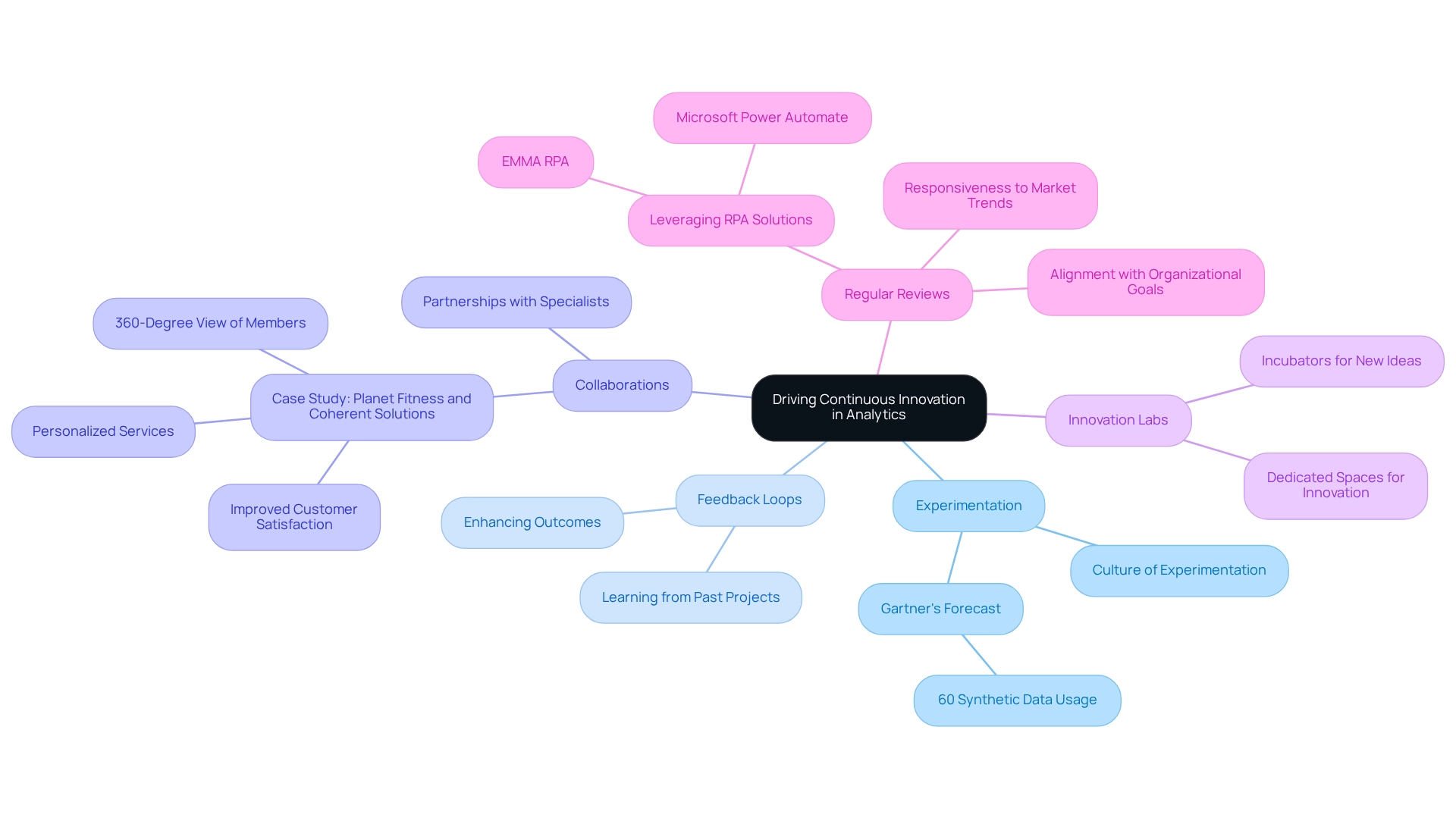
Best Practices for Building a Successful Analytics CoE
Building a successful CoE Analytics Center of Excellence (CoE) requires a strategic approach grounded in best practices that foster engagement and drive results.
- Define Clear Objectives: Establishing specific, measurable objectives is crucial for aligning the CoE’s initiatives with the broader organizational goals. This clarity helps in prioritizing efforts and measuring success effectively.
For instance, organizations can set clear marketing goals and align them with relevant metrics, tracking key performance indicators to measure progress and effectiveness. Utilizing Business Intelligence tools can convert raw information into actionable insights, facilitating informed decision-making that propels growth and innovation.
- Engage Stakeholders: Active participation of key stakeholders from the outset is crucial for obtaining buy-in and support for data initiatives.
In 2025, entities that emphasize stakeholder involvement are likely to experience increased collaboration and trust in information, resulting in better decision-making and operational effectiveness. As stated by MicroStrategy, merely 3% of employees could access the information necessary for business decisions in seconds, while 60% required hours or days, highlighting the necessity for effective analytics and the role of RPA in optimizing workflows. Creatum GmbH can assist organizations in overcoming these challenges by implementing customized RPA solutions that improve information accessibility and operational efficiency.
-
Invest in Training: Ongoing training for group members is essential to improve their analytical skills and keep them informed of the latest industry trends. This investment not only boosts individual capabilities but also strengthens the overall effectiveness of the CoE Analytics. Customizing AI solutions, like Small Language Models and GenAI Workshops, can further enhance information quality and enable teams to utilize AI effectively.
-
Establish Governance: Implementing robust governance frameworks is necessary to ensure information quality and compliance with relevant regulations. Robust governance practices assist in reducing risks linked to information management and improve the trustworthiness of analytical results. Addressing data inconsistency and governance challenges is essential for enhanced decision-making and operational efficiency.
-
Measure Success: Regularly assessing the CoE’s impact on business outcomes is critical for demonstrating its value. By monitoring essential performance metrics and aligning them with organizational goals, leaders can obtain continuous backing and resources for data initiatives. A successful CoE Analytics can lead to better decision-making, lower expenses, and improved collaboration among departments, ultimately fostering growth and innovation.
Integrating these best practices can greatly improve the efficiency of a data Center of Excellence. For instance, organizations that have successfully implemented these strategies report greater trust in their data and improved collaboration across departments, leading to a more competitive edge in the market. Additionally, utilizing Enhanced Ecommerce can help identify areas for improvement and optimize the online shopping experience, further aligning with the theme of operational efficiency.
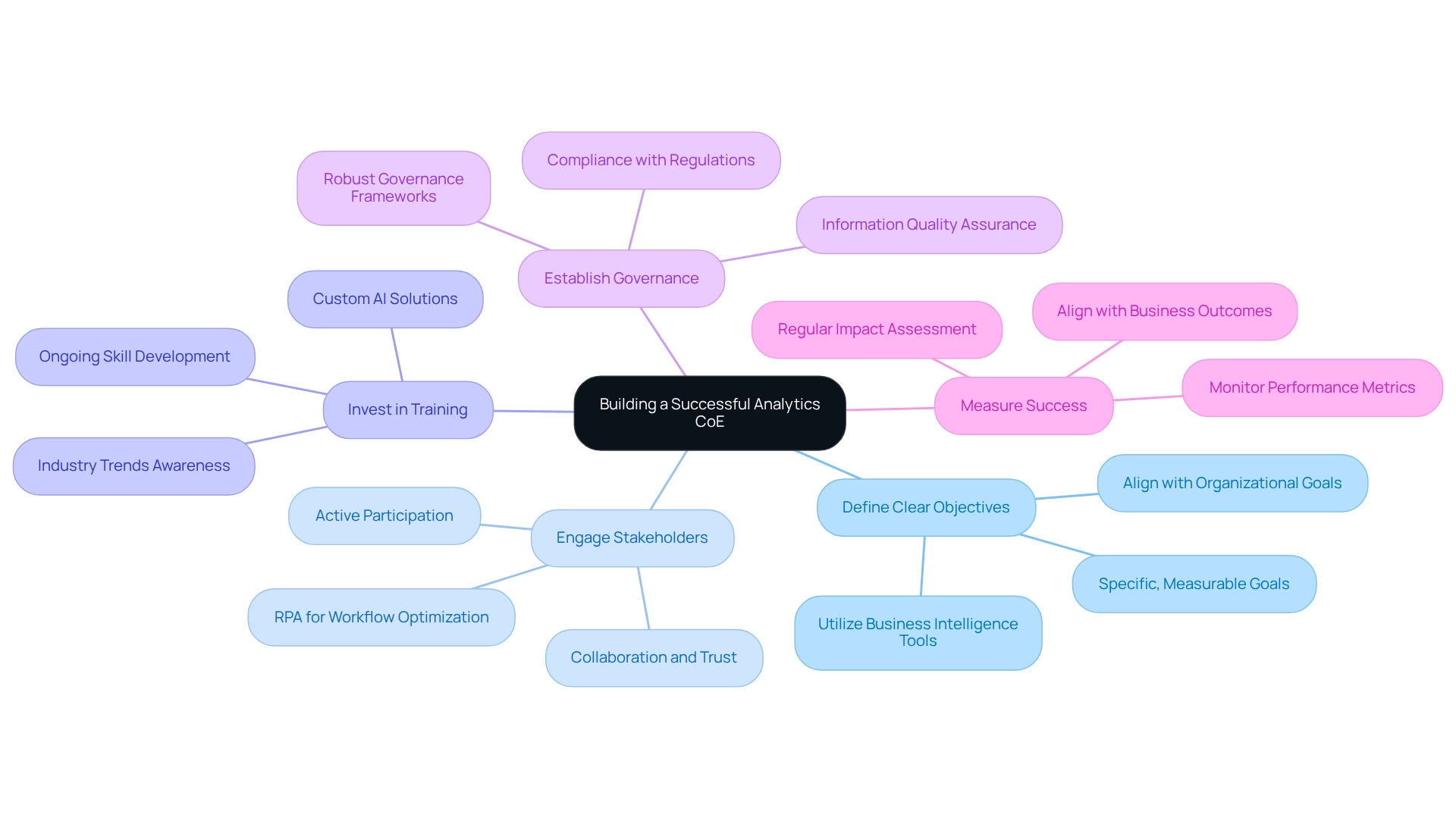
Measuring ROI and Realizing Benefits from Analytics
Measuring ROI and realizing benefits from analytics initiatives involves several critical steps that can significantly enhance operational efficiency and drive business success.
-
Define Metrics: Establishing clear and relevant metrics for success is essential. This process not only measures the effect of coe analytics efforts but also aligns them with organizational objectives. Companies that define specific KPIs, such as customer acquisition costs or revenue growth rates, can better assess the effectiveness of their analytics initiatives. The effectiveness of a company’s information strategy is reflected in its positive financial impact, including cost reductions and wider profit margins. Incorporating Robotic Process Automation (RPA) from Creatum GmbH into this process can further simplify the definition of these metrics by automating information collection and analysis, thus minimizing errors and liberating team resources for more strategic tasks.
-
Track Performance: Regularly monitoring performance against these defined metrics allows organizations to assess the effectiveness of their data initiatives. Employing coe analytics through cloud-based information analysis platforms provides scalability and adaptability for handling increasing volumes, ensuring that performance monitoring remains strong and informative. RPA can improve this tracking by automating the information retrieval process, allowing teams to concentrate on analysis rather than information collection.
-
Communicate Results: Effectively conveying the outcomes of data projects to stakeholders is crucial for securing ongoing support and funding. Clarity in reporting fosters trust and emphasizes the positive financial effects of a well-executed information strategy. As mentioned by the Svitla Team, “Reach out to discover more about our method for strategic collaboration and ways we could assist your business in strategizing and obtaining ROI from analytics.” Leveraging RPA can also facilitate more timely and accurate reporting, ensuring stakeholders receive the insights they need promptly.
-
Adjust Strategies: Leveraging insights gained from performance tracking to refine strategies is vital for continuous improvement. Organizations that adapt their approaches based on data-driven insights can enhance their operational efficiency and better meet their objectives. RPA can play a key role here by automating the analysis of performance information, allowing for quicker adjustments to strategies based on real-time insights.
-
Benchmarking: Comparing performance against industry standards aids entities in identifying areas for enhancement and innovation. Retailers such as Amazon and Best Buy have effectively employed information analysis to tackle fraud by concentrating on KPIs like chargeback rates and order approval rates. This case study illustrates how tracking these specific metrics leads to faster fraud detection and minimizes the impact of fraudulent activities. By incorporating RPA from Creatum GmbH into benchmarking processes, companies can automate the comparison of their metrics against industry standards, leading to more efficient identification of improvement areas.
By adhering to these steps and utilizing RPA from Creatum GmbH, organizations can effectively measure the ROI from their data initiatives, ensuring that they not only track performance metrics but also employ coe analytics to convert information into actionable insights that promote growth and innovation.
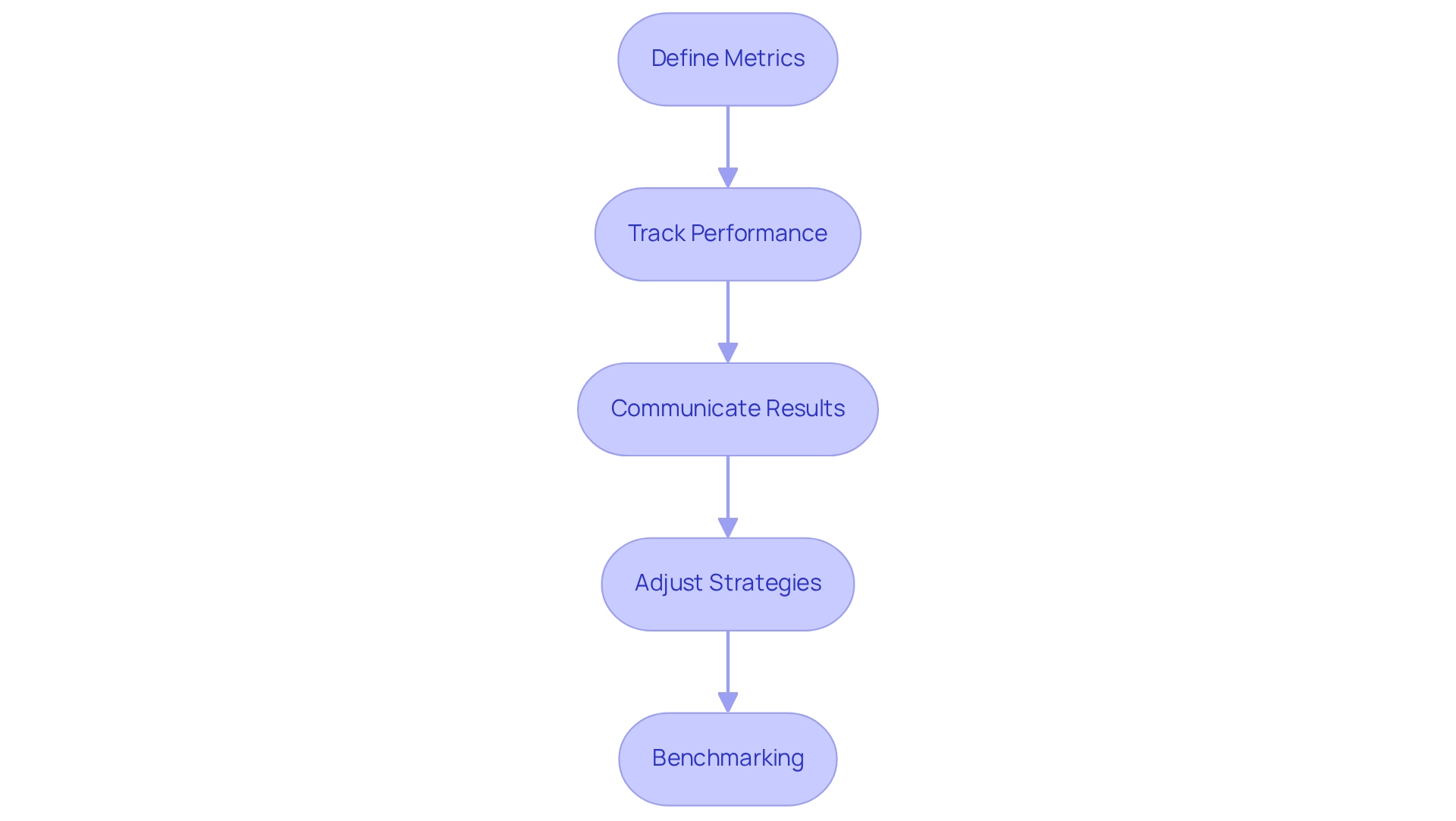
Methodologies and Best Practices for Effective Analytics
Utilizing effective methodologies and best practices in coe analytics is crucial for attaining optimal results in 2025 and beyond. Key methodologies include:
-
Agile Analytics: Embracing agile methodologies fosters flexibility and rapid iteration in analytics projects, allowing teams to adapt quickly to changing requirements. This method has been demonstrated to enhance project success rates, with companies reporting a 30% improvement in delivery timelines when agile practices are adopted.
-
Data-Informed Decision Making: Fostering a culture of data-informed decision-making guarantees that insights are effectively leveraged throughout the entity. Companies that prioritize data-driven strategies are 5 times more likely to make faster decisions than their competitors, leading to enhanced operational efficiency and strategic alignment. Hypothesis testing in statistical analysis plays a crucial role here, as it helps confirm or reject business assumptions about customer preferences, further enhancing decision-making processes.
-
Predictive Analytics: The implementation of predictive analytics empowers organizations to anticipate future trends and make proactive decisions. By utilizing historical information, businesses can predict customer behavior and market changes, leading to a 20% rise in revenue for those who effectively employ these insights.
-
Information Visualization: Employing information visualization methods greatly improves the accessibility and understanding of intricate sets of information. Effective visualizations can improve stakeholder engagement and facilitate quicker decision-making, as they transform raw data into intuitive formats that highlight key insights.
-
Continuous Improvement: Establishing a framework for ongoing enhancement ensures that data processes evolve in response to changing business needs. Organizations that embrace a mindset of continuous improvement in their data practices report a 15% increase in overall performance metrics, demonstrating the value of adaptability in data analysis.
Furthermore, comprehending the two primary forms of statistical analysis—descriptive and inferential—is essential for effective analytical methods. A recent case study on common statistical errors in biomedical research emphasizes the significance of utilizing suitable tests for information types and avoiding misinterpretation of results. This underscores the need for proper training or consultation to improve the quality of statistical analyses.
As Dr. Prabhaker Mishra notes, “proper consultation from statistical experts may be an alternative option and can reduce the burden from the clinicians to go in depth of statistics which required lots of time and effort and ultimately affect their clinical works.” Integrating these methodologies not only simplifies coe analytics processes but also fosters innovation and growth. For example, a recent case study emphasized how a healthcare entity enhanced its patient results by utilizing agile analysis to improve its information gathering and reporting methods, ultimately resulting in more informed clinical decisions.
As industry leaders highlight, the integration of agile analytical methodologies, alongside Robotic Process Automation (RPA) solutions like EMMA RPA and Microsoft Power Automate, is essential for organizations seeking to excel in a data-rich environment while tackling issues such as poor master data quality and obstacles to AI adoption. RPA not only automates manual workflows but also enhances efficiency and reduces errors, making it an essential component of modern analytics strategies.
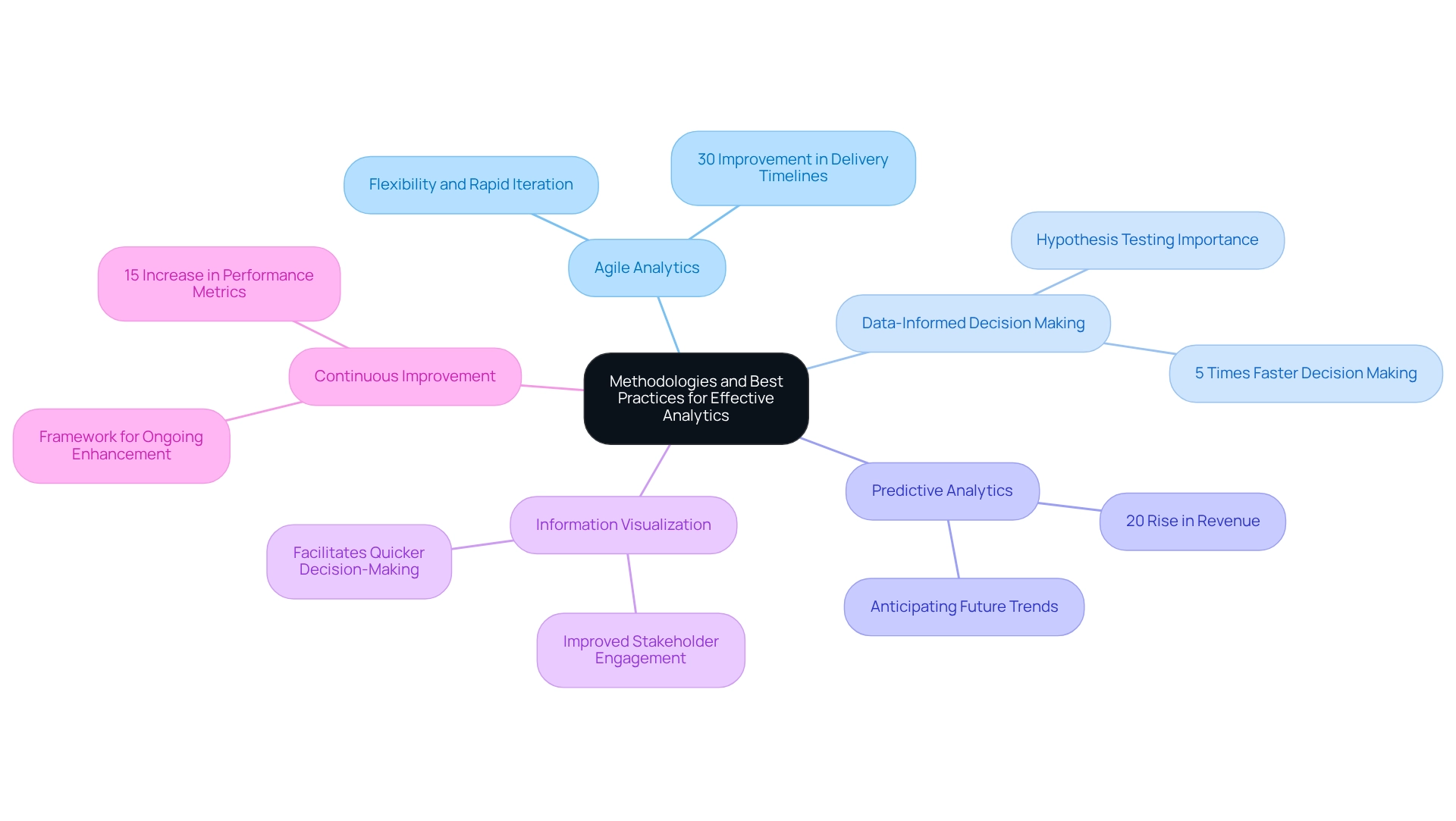
Conclusion
Establishing a Center of Excellence (CoE) in analytics represents a transformative step for organizations aiming to fully leverage their data assets. By centralizing expertise and resources, a CoE fosters a culture of collaboration and innovation. This enables businesses to align their analytics efforts with strategic objectives. Essential components contributing to the success of a high-performing analytics CoE include:
- Leadership support
- A skilled team
- Clear objectives
- A robust technological infrastructure
To effectively harness the power of data, organizations must prioritize data quality and governance. This ensures that comprehensive policies are in place to maintain reliability and compliance. Regular audits and training initiatives are critical for sustaining high standards and fostering a data-driven culture. Additionally, optimizing resources through cross-functional teams and investing in advanced analytics tools can significantly enhance productivity and operational efficiency.
Driving continuous innovation is equally vital. By embracing experimentation and establishing feedback loops, organizations can refine their analytics methodologies and adapt to evolving market demands. The integration of emerging technologies, such as Robotic Process Automation (RPA), not only streamlines workflows but also empowers teams to focus on strategic initiatives rather than repetitive tasks.
Ultimately, the journey toward a successful analytics CoE is marked by a commitment to best practices, continuous learning, and a focus on measurable outcomes. By implementing these strategies, organizations can unlock the full potential of their data, driving informed decision-making and fostering sustainable growth in a competitive landscape. The future of analytics lies in embracing these principles, ensuring that data becomes a pivotal driver of innovation and success.
Frequently Asked Questions
What is a Center of Excellence (CoE) in data analysis?
A Center of Excellence (CoE) in data analysis, known as coe analytics, is a centralized hub that consolidates expertise, resources, and best practices to enhance an organization’s analytical capabilities. It fosters teamwork and strategic alignment among scientists, analysts, and business stakeholders to advance information initiatives aligned with organizational objectives.
Why is creating a CoE particularly advantageous in today’s information-rich landscape?
Creating a CoE is advantageous because organizations face the challenge of transforming vast quantities of information into actionable insights. CoE analytics helps standardize practices and enhance information analysis capabilities, positioning organizations to harness insights for competitive advantage.
What role does leadership support play in the success of a CoE?
Strong backing from senior management is vital for securing necessary resources and fostering a culture of data-driven decision-making. Research indicates that organizations with strong leadership backing for data initiatives can achieve a 25% improvement in overall results.
What are the essential components of a high-performing data analysis CoE?
Essential components include leadership support, an experienced group, clear objectives, a collaboration framework, and a robust technology infrastructure. Each component contributes to driving the success of the CoE.
How does integrating Robotic Process Automation (RPA) benefit a CoE?
Integrating RPA within a CoE streamlines manual workflows, enhances operational efficiency, and allows teams to focus on strategic initiatives by reducing time spent on repetitive tasks, leading to improved productivity and accuracy.
What strategies are important for ensuring information quality and governance in a CoE?
Key strategies include appointing information stewards, conducting regular audits, implementing standardization, providing training, and establishing feedback mechanisms to enhance accountability and maintain high-quality information.
How can organizations measure the success of their CoE analytics initiatives?
Organizations can measure success by evaluating the quality of information through key metrics and KPIs, as well as assessing improvements in decision-making speed and operational efficiency as a result of effective analytics practices.
What is the significance of continuous education for leadership in a CoE?
Continuous education is essential for leadership development as it provides leaders with updated knowledge and skills necessary for effective decision-making and innovation, ultimately enhancing the results of data initiatives.

